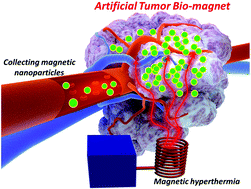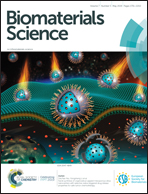An artificially engineered “tumor bio-magnet” for collecting blood-circulating nanoparticles and magnetic hyperthermia†
Abstract
It is a great challenge to directly endow a tumor with specific functions for theranostic treatment. In this study, we report on a novel approach to transform a tumor into a “bio-magnet”, to be magnetized on demand, in order to create an intrinsic tumor magnetic field that would collect magnetic nanoparticles (MNPs) circulating in the blood and achieve simultaneous magnetic hyperthermia. This was achieved by the localized intratumoral injection of liquid Nd2Fe14B/Fe3O4-PLGA, followed by solvent exchange that induces a liquid-to-solid transformation. After the magnetism charging process, the solid Nd2Fe14B/Fe3O4-PLGA implant was endowed with permanent magnetic properties and in situ created the magnetic field within the tumor tissue, making the tumor a “bio-magnet”. After the creation of the bio-magnet, intravenously injected MNPs accumulated into the tumor tissue due to the tumor magnetic field. Importantly, both the in vitro and ex vivo results demonstrated the high efficiency of the implanted bio-magnet for magnetic hyperthermia. This new approach achieves magnetic targeting by creating a tumor “bio-magnet”, which generates a strong magnetic field within the tumor, paving a new way for the development of an efficient targeting strategy for tumor therapy.



 Please wait while we load your content...
Please wait while we load your content...